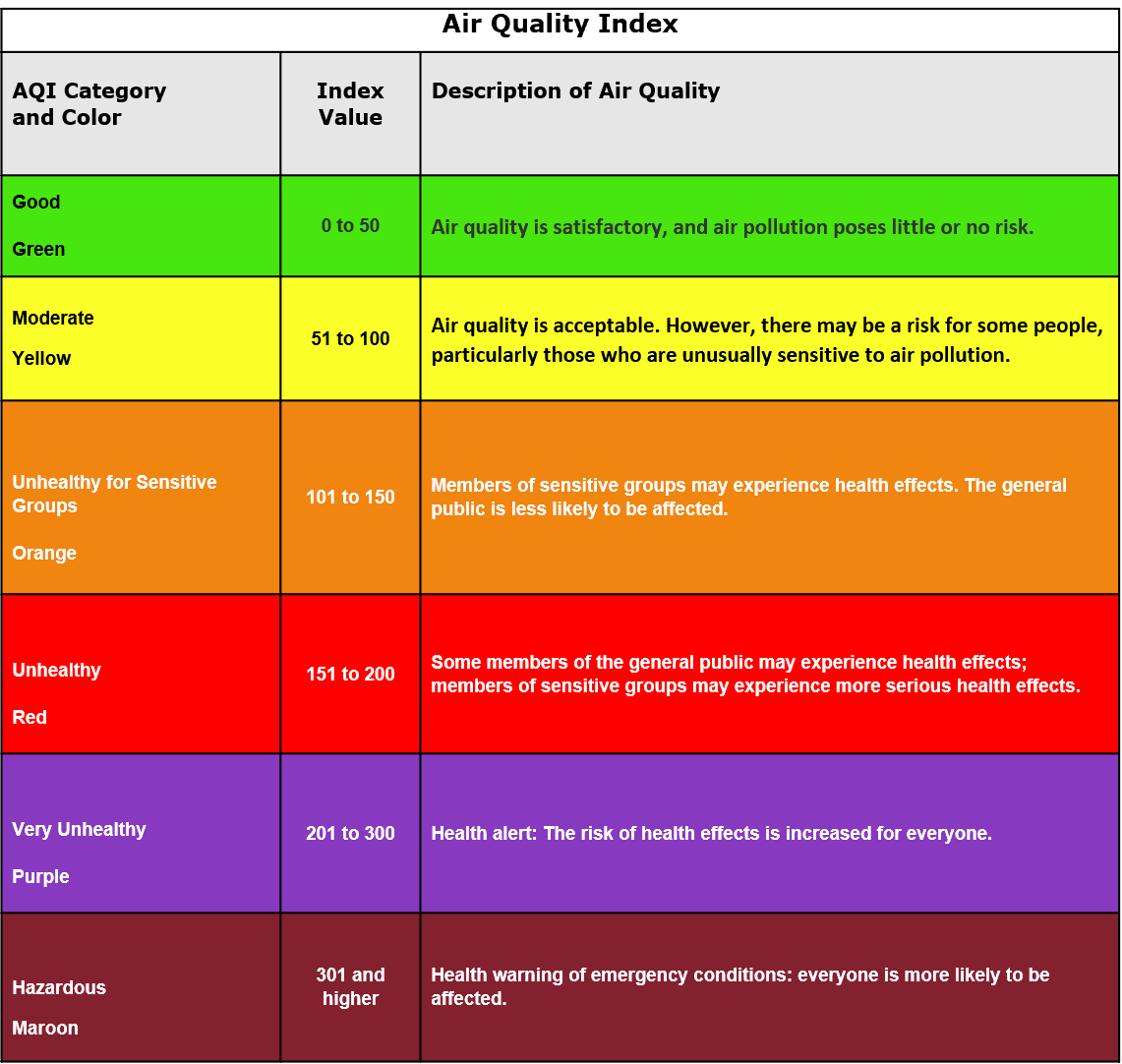Wildfire Smoke
Wildfire smoke is a mix of gases and fine particles from burning trees and plants, buildings, and other material. In 2023, wildfires in Canada have been affecting the air quality in the United States, even as far south as Iowa and Nebraska.
Wildfire smoke can make anyone sick, but people with asthma, Chronic Obstructive Pulmonary Disease (COPD), or heart disease, or who are pregnant and children and responders are especially at risk.
Breathing in smoke can affect you right away, causing:
- Coughing
- Trouble breathing
- Wheezing
- Asthma attacks
- Stinging eyes
- Scratchy throat
- Runny nose
- Irritated sinuses
- Headaches
- Tiredness
- Chest pain
- Fast heartbeat
Air Quality Indexes (AQIs)
The Environmental Protection Agency (EPA) developed the Air Quality Index, or AQI, to make information available about the health effects of the five most common air pollutants, and how to avoid those effects.

Moderate AQI (yellow)
During Moderate AQI (Yellow category) conditions, those who are unusually sensitive to particle pollution may experience health effects. When conditions rise to the yellow category, those who are unusually sensitive are advised to consider shortening outdoor activities and reducing the intensity of these activities. Symptoms such as coughing or shortness of breath are signs to take it easier.
Unhealthy for Sensitive Groups AQI (orange)
During Unhealthy for Sensitive Groups AQI (Orange category) conditions, members of sensitive groups may experience health effects. Sensitive groups include people with heart or lung disease, older adults, and children. When conditions rise to the orange category, sensitive groups are advised to reduce prolonged or heavy exertion and avoid intense outdoor activities. Everyone else can remain active and adjust activity duration and intensity as needed.
Unhealthy AQI (red)
During Unhealthy AQI (Red category) conditions, some members of the general public may experience health effects and members of sensitive groups may experience more serious health effects. Sensitive groups include people with heart or lung disease, older adults, and children. When conditions rise to the red category, everyone is advised to avoid prolonged or heavy exertion and those in sensitive groups should consider moving activities indoors or rescheduling.
Protect Yourself Against Wildfire Smoke and Ash
There are several ways you can protect yourself and others in your home/community from the affects of wildfire smoke.
- Know what the air quality will be like, and whether your community is going to be affected. Emergency Alert Systems, local weather stations, and the National Oceanic and Atmospheric Administration (NOAA) Weather Radio are all resources for emergencies and alerts. A list of resources is at the bottom of this page.
- Limit your exposure to wildfire smoke. Reduce the amount of time you spend outdoors when air quality is poor. Keep doors and windows closed, and turn on your HVAC system to filter the air, or use a portable air cleaner. Use high efficiency filters in your central air conditioning system to capture fine particles from the smoke.
- Avoid putting additional smoke or pollutants in the air. If you can, avoid using candles, gas, propane, wood-burning stoves, fireplaces, or aerosol sprays. Don't fry or broil meat, smoke tobacco products, or vacuum.
- Pay attention to your health symptoms. Wildfire smoke can affect anyone. Children, older adults, pregnant people, and people with heart or lung disease (such as asthma or COPD) should be especially careful. It’s important for people with heart or lung disease to have a supply of medicine ready in case they do begin to feel symptoms.
If You Must Be Outside
If you must be outside, wear an N95 respirator. This is especially important for people who work outdoors or who can't reduce the amount of time they spend outside.
- A respirator is a mask that fits tightly to your face to filter out smoke before you breathe it in. You must wear the right respirator and wear it correctly. Follow the user instructions for the respirator or mask. These instructions may show how to make sure it fits properly.
- If you have heart or lung disease, ask your doctor if it is safe for you to wear a respirator.
- A surgical mask is designed to capture infectious particles generated by the wearer, is not a respirator, and provides little or no protection from smoke particles.
The National Institute for Occupational Safety and Health (NIOSH) has not approved respirators for children but children ages 2 years and older can wear respirators and masks. NIOSH Approved respirators do not come in suitable sizes for very young children.
- Choose a comfortable respirator or mask that your child can wear properly. If a respirator or mask fits poorly or is uncomfortable, a child might take it off or wear it incorrectly (for example, pulling it down from their nose). This reduces the intended benefits.
- Choose a size that fits over the child’s nose and under the chin but allows them to see.
- NIOSH Approved respirators and international respirators may be available in smaller sizes that fit children. However, manufacturers typically design them to be used by adults in workplaces. They may not have been tested for broad use in children.
Other Resources and Information
-
AirNow has a map of fires throughout North America.
-
NOAA's page has maps of fire watches and warnings along with other information.
-
Downloadable pdf with information on keeping pets safe
-
Downloadable pdf with information on livestock and large animal safety during wildfires
-
Downloadable pdf with pictures and instructions

